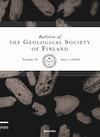Orientation of gravels and soft-sediment clasts in subaqueous debrites – implications for palaeodirection reconstruction: case study from Puck Bay, northern Poland
IF 1.3
4区 地球科学
Q2 GEOLOGY
引用次数: 3
Abstract
Subaqueous debrites on a fan were recognized at Rzucewo (N Poland). Analysis of debrite fabric enabled debris-flow palaeodirections to be traced on the fan. The long axis azimuth and dip direction of lithic clasts (gravels) as well as soft-sediment clasts (SSC) were measured in the debrites. The results obtained indicate a palaeotransport direction to NNW, similar to the palaeocurrents interpreted from the asymmetrical ripples. However, detailed measurements of both gravels and SSC orientation show variability of palaeoflow directions between NW and NE sectors. In the proximal part of the fan, gravels indicate variable dip directions and dip angles, and a mostly scattered distribution of a-axis orientation. In the medial and distal parts of the fan, clasts are better ordered and usually their a-axes are oriented upslope or transverse to the palaeoslope inclination direction. Probably during the decelerating and halting of debris flows, the compression processes induced clast rotation and a change of inclination. In the distal part of the fan, debrites reveal a distinct variability of palaeoflow directions caused by flattened topography in which debris-flow lobes split and spread freely in different directions. Finally, we conclude that the individual sets of clast fabric usually indicate only local debris-flow directions.水下碎屑中砾石和软沉积碎屑的方位——古方位重建的意义:以波兰北部Puck湾为例
在Rzucewo(波兰北部)发现了扇上的水下碎屑。通过对碎屑岩组构的分析,可以在扇体上追踪到碎屑流的古方向。测量了碎屑岩中岩屑碎屑(砾石)和软质沉积物碎屑(SSC)的长轴方位角和倾角。所获得的结果表明了向NNW的古迁移方向,类似于从不对称波纹中解释的古洋流。然而,砾石和SSC方位的详细测量表明,NW和NE扇区之间的古水流方向存在可变性。在扇的近端,砾石显示出可变的倾斜方向和倾角,以及a轴方向的大部分分散分布。在扇的中部和远端,碎屑排列有序,其a轴通常向上倾斜或横向于古斜坡倾斜方向。可能在泥石流减速和停止期间,压缩过程引起了碎屑旋转和倾斜度的变化。在扇的远端,碎屑岩揭示了由平坦地形引起的古水流方向的明显变化,在平坦地形中,碎屑流瓣向不同方向自由分裂和扩散。最后,我们得出结论,单独的碎屑组构通常只指示局部泥石流方向。
本文章由计算机程序翻译,如有差异,请以英文原文为准。
求助全文
约1分钟内获得全文
求助全文
来源期刊
CiteScore
1.30
自引率
0.00%
发文量
5
审稿时长
>12 weeks
期刊介绍:
Bulletin of the Geological Society of Finland (BGSF) publishes research articles and short communications in all branches of geosciences. Contributions from outside Finland are welcome, provided that they contain material relevant to Finnish geology or are of general interest.

 求助内容:
求助内容: 应助结果提醒方式:
应助结果提醒方式:


